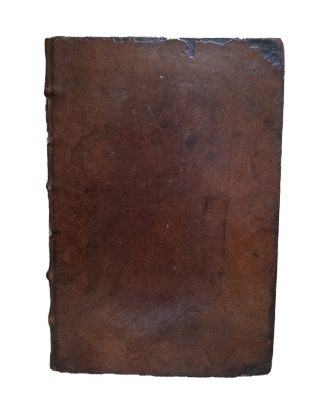VIEUSSENS, Raymond.
Neurographia universalis
Lyon, Jean Certe, 1685£7,850.00
FIRST EDITION Folio, (xx) 252 (iv). Roman and italic letter. Woodcut floriated initials, charming headpieces and tailpiece with foliage and flowers. T-p in red and black with engraved printer’s monogram, large oval portrait of Vieussens signed “Math[ieu] Boulanger Fe[cit]”, arms of cardinal Piero de Bonzi (1631-1703), 30 numbered anatomical half to full-page plates (10 folding). Small ink splashes to margins of half title and next 4 ll., t-p a bit dusty, age yellowing, light browning in places, minor mainly marginal foxing to a few final gatherings, small burn mark touching a couple of letters (text restored), tear to lower blank margin of one fol. A very good copy in contemporary French calf, spine with raised bands and guilt ornaments in compartments, gilt title label, edges sprinkled red. Ms “Ex libris Ioannis Novaro-Mascarello med. chirg – Aug. Taurinorum – Idibus – Martiis 1879” to half-title, engraved armorial bookplate on verso of t-p.
Second issue of the first edition of this influential and attractively illustrated work on the anatomy of the nervous system by Vieussens (first 1684), in a contemporary French binding.
Raymond Vieussens (c. 1635 – 1715) was a French physician and pioneer of anatomic work in neurology and cardiology. Son of a lieutenant-colonel, he financed his own education in philosophy at Rhodez and then completed medical school at the University of Montpellier in 1670. After graduating, he was appointed physician to the hospital of Saint Eloy in Montpellier. Here, during the first ten years of service, he sectioned five hundred human bodies, and the results of these examinations were published in his masterpiece: “Neurographia universalis”. This is considered the most complete and authoritative description of the brain and the spinal cord up to that time and the “best illustrated work on the subject to appear in the 17th century” (Garrison-Morton). In the introduction, Vieussens states that his aim was: “not only to improve, as much as I could, the beautiful Treatise on the Brain and the Spinal Cord of the celebrated Willis [i.e. Thomas Willis (1621-1675)], but in addition to describe exactly all the nerves of the extremities, the description of which he dared not undertake, saying that it was a work of an infinitely great and infinitely tedious labor […] I undertook indeed to describe the nerves of the skin although M. Diemerbroeck had regarded their description as impossible”.
The work is divided into three volumes, the first dedicated to the brain, the second to the spinal cord and the third to the nerves (both intracranial and peripheral). The edition is enriched by numerous, detailed and beautifully engraved plates realised by Jacques Beaudeau, one of the greatest engravers in Montpellier. It contains a number of important anatomical descriptions and discoveries: “In Chapter 10 of the first volume titled “De distinctis duabus cerebri substantiis” (“the two distinct substances of the brain”), Vieussens clearly differentiated between white and grey matter, highlighting the different texture between the two […] In Chapter 11, “De cerebro stricte sumpto” (“the brain considered in strict sense”), Vieussens described the hemispheres and the convexity of the brain. He gave a detailed account of the corpus callosum […], identifying it as a white matter structure connecting the two halves of the brain. He then illustrated the centrum ovale, the oval-shaped white matter lying beneath the cortex and surrounding the corpus callosum and the ventricle walls […] The introduction of the term “centrum ovale” is one of the legacies to the field of neuroanatomy left by Vieussens. […] Vieussens was able to demonstrate, for the first time, the continuity of the white matter through what is known today as the internal capsule, down to the pyramidal tracts and the brainstem.” (Vergani et al.)
This copy bears the ex-libris, dated March 1879, of an Italian doctor and surgeon named Giovanni Novaro-Mascarello. He is recorded in a yearbook of the Kingdom of Italy of 1892, in the section concerning Piedmont. The armorial bookplate pasted on verso of the title page, depicting an ox, is almost identical to the arms of the city of Boves, in the province of Cuneo (Piedmont), where the surname Mascarello is most diffused.
Heirs of Hippocrates 421; Garrison-Morton 1379 and Goldsmith 375 (first issue). Not in USTC, Brunet or Graesse. Vergani et al., Raymond de Vieussens and his contribution to the study of white matter anatomy (2012)In stock











